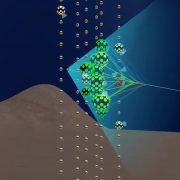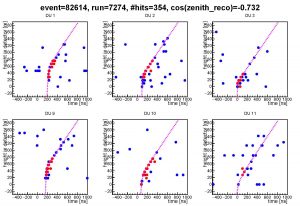 05 February 2020 – The ORCA6 detector of KM3NeT is taking data since 27 January 2020 on a 24/7 scheme. Physicists are ‘on-shift’ to remotely or on-site operate the detector in the deep sea. The recorded data is stored in the computer centres of the KM3NeT Collaboration for further analysis.
05 February 2020 – The ORCA6 detector of KM3NeT is taking data since 27 January 2020 on a 24/7 scheme. Physicists are ‘on-shift’ to remotely or on-site operate the detector in the deep sea. The recorded data is stored in the computer centres of the KM3NeT Collaboration for further analysis.
The first step is to reconstruct from the recorded light flashes the path of charged particles through the ORCA6 detector. Most of them are muon particles generated in the Earth’s atmosphere and travelling through the detector from above. We showed already an example in the news item of 27 January.
In the video below we show a series of five charged particles entering the detector from below or from the side. This is an indication that they have been created in an interaction of a neutrino with the matter surrounding the detector.
In the picture below, you see the plots that KM3NeT physicists like: six plots showing for each of the six detection units in ORCA6 the optical sensors that – in the pitch dark deep sea – are ‘hit’ by faint light. Each time a sensor is hit, the position of that sensor in the sea and the time it was hit is recorded. The plots show on the y-axis the height of the sensors in the detector and on the x-axis the time. The red circles and the red line show how the light cone generated by a charged particle from below has crossed the detector. As function of time (in nanoseconds), the position of the next hit sensor is higher in the detector, indicating that the particle is travelling upwards. The blue circles are background hits.


